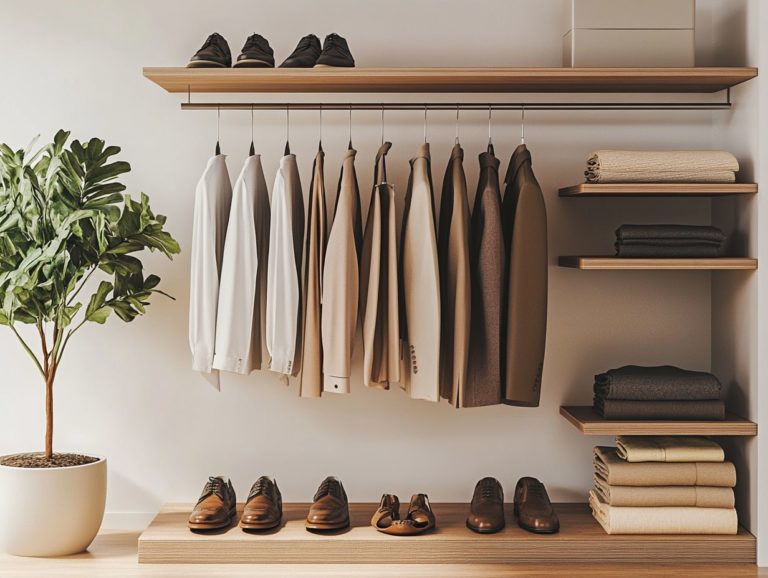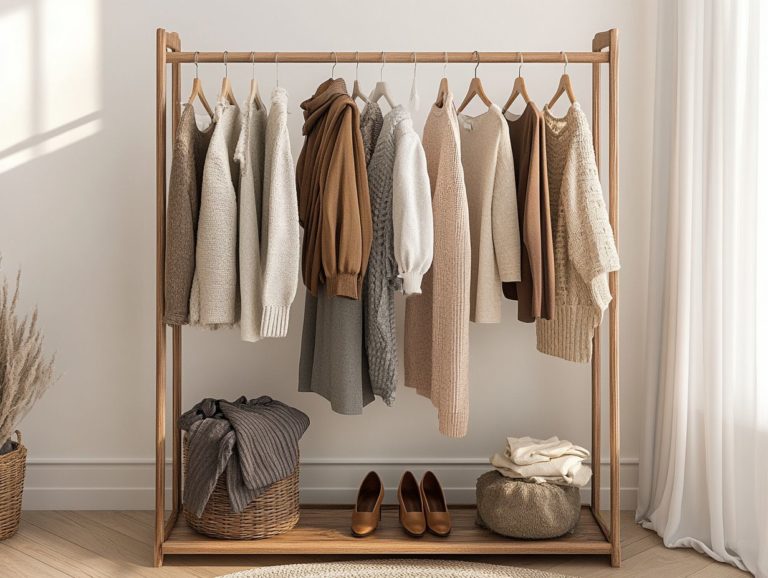How Many Clothes in a Minimalist Wardrobe?
In today s fast-paced world, the appeal of a minimalist wardrobe is undeniably compelling. Picture a closet curated with only versatile, essential pieces that not only reflect your style and values but also eliminate decision fatigue and clutter.
This article delves into the concept of minimalist fashion, showcasing its benefits, including sustainability and cost-effectiveness.
Get ready to transform your wardrobe and embrace a stylish, intentional way of dressing!
Contents
- Key Takeaways:
- The Concept of a Minimalist Wardrobe
- Benefits of a Minimalist Wardrobe
- How to Build a Minimalist Wardrobe
- How Many Clothes Do You Need?
- Maintaining a Minimalist Wardrobe
- Frequently Asked Questions
- How Many Clothes in a Minimalist Wardrobe?
- What are the benefits of having a minimalist wardrobe?
- How do I decide which clothes to keep in my minimalist wardrobe?
- Can I still have a personal style with a minimalist wardrobe?
- Do I have to get rid of all my clothes to have a minimalist wardrobe?
- How can I maintain a minimalist wardrobe in the long run?
Key Takeaways:

- A minimalist wardrobe is defined by having a limited number of quality pieces that can be mixed and matched for different outfits, emphasizing quality over quantity.
- Benefits of a minimalist wardrobe include less clutter, increased focus, sustainability, and a positive environmental impact.
- When building a minimalist wardrobe, assess your current wardrobe, determine your personal needs, and include key pieces such as basic tops and bottoms, versatile outerwear, and quality shoes.
The Concept of a Minimalist Wardrobe
The idea of a minimalist wardrobe centers on the principles of minimalism. It encourages you to make intentional choices in fashion that emphasize versatility and quality rather than quantity. A minimalist wardrobe aims to curate a clutter-free closet filled with essential pieces that embody your personal style while alleviating the decision fatigue that often accompanies daily outfit choices.
By adopting a capsule wardrobe, you can embrace a more organized and streamlined approach to clothing. This not only enhances your self-expression but also reduces your environmental footprint in the face of consumerism, aligning with thoughtful purchasing.
Defining Minimalism in Fashion
Defining minimalism in fashion requires you to appreciate how intentional choices can shape your personal style and wardrobe decisions. This philosophy invites you to focus on quality over quantity, allowing you to curate a wardrobe filled with versatile pieces that truly reflect your taste and align with sustainable practices.
In contrast to fast fashion, which often fuels a never-ending cycle of consumption driven by fleeting trends and disposability, minimalism champions the idea of thoughtful purchasing. It encourages you to invest in timeless garments that withstand the test of style and boast durability.
By prioritizing fewer, high-quality items, you can effectively reduce waste and support ethical brands. This approach contributes to a more sustainable fashion industry and enhances your personal expression through thoughtful, meaningful choices.
Benefits of a Minimalist Wardrobe
A minimalist wardrobe presents a wealth of advantages, from diminishing decision fatigue to fostering a positive environmental impact and enhancing cost-effectiveness. This approach simplifies your daily choices and aligns beautifully with the values of modern consumers, making it an appealing option worth considering.
Less Clutter and More Focus
One of the primary advantages of a minimalist wardrobe is that it allows you to create a clutter-free closet, fostering a sharper focus on your individual style and outfit selection.
By reducing the physical chaos that often comes with an overflowing wardrobe, you can enjoy improved mental clarity. This newfound clarity enables you to make more decisive and confident choices when getting dressed each day. A well-organized closet, paired with an effective clothing inventory and wardrobe checklists, becomes an invaluable tool in maintaining this streamlined approach.
These strategies not only simplify your selection process but also encourage intentionality in your clothing purchases, reflecting your personal values and lifestyle needs. Spending less time on decision-making frees up mental space for creativity and productivity in other areas of your life.
Sustainability and Cost-Effectiveness

A minimalist wardrobe champions sustainability by reducing fast fashion. It also proves to be a smart financial choice, encouraging thoughtful spending.
By opting for quality fabrics and versatile pieces, you can cut down on microplastics and textile waste. These choices benefit our planet’s health and support organizations tackling environmental issues.
Investing in fewer, high-quality items leads to long-term savings. These garments last longer and need replacement less often.
Donating clothing you no longer need gives those items a second life. It reduces resource consumption and promotes a system where items are reused instead of discarded.
How to Build a Minimalist Wardrobe
Curating a minimalist wardrobe is an exciting journey that starts with evaluating your existing clothing collection. This is paired with a planned approach for choosing essential pieces that define your style.
Each selection should be intentional, ensuring that every item serves a purpose, aligns with your minimal style, and contributes to a cohesive and versatile wardrobe.
Assessing Your Current Wardrobe
Assessing your current wardrobe is an essential first step in curating a minimalist collection. It allows you to identify pieces that add to decision fatigue and clutter.
By conducting a comprehensive clothing inventory, you can gain insight into which items truly reflect your personal style and serve a practical purpose in your daily life.
Start with a wardrobe checklist to categorize and evaluate each piece. Ask yourself how often you wear it and its functional value. This approach highlights overlooked garments and prompts reflection on the emotional connections you may have with certain items.
Understanding how each piece aligns with your lifestyle simplifies your choices and enhances your overall satisfaction with your wardrobe. This paves the way for seasonal updates and efficient management.
Key Pieces to Include
The key pieces to cultivate in your minimalist wardrobe are versatile items such as jackets, shoes, dresses, denim jeans, blazers, and scarves. These can be mixed and matched, allowing you to create various outfits while maintaining a cohesive personal style.
Essential clothing items like well-fitted jackets, timeless denim jeans, elegant blazers, and stylish dresses are central to this concept. A tailored jacket can seamlessly transition from a casual outing to a professional setting, embodying both comfort and sophistication.
Denim jeans provide an effortless foundation for countless looks, solidifying their status as a staple in your collection. Meanwhile, a structured blazer elevates even the simplest ensembles, proving that true style doesn t require excess.
When chosen wisely, dresses can be dressed up or down. This significantly enhances your wardrobe’s versatility. By incorporating these must-have essentials for your minimalist wardrobe, you can embrace the principles of minimalism, ensuring that every piece serves a purpose while contributing to an effortlessly chic aesthetic.
How Many Clothes Do You Need?
Determining the exact number of clothes you truly need is crucial for cultivating a minimalist wardrobe. This thoughtful approach enables you to make intentional choices that resonate with your personal needs and lifestyle.
Allowing for a more curated and meaningful collection enhances your overall experience in building a minimalist wardrobe.
Determining Your Personal Needs

Determining your personal needs in fashion is essential for building a simple wardrobe that truly aligns with your lifestyle and preferences.
Take a moment to evaluate your daily activities. Whether you’re commuting to work, attending social events, or embarking on outdoor adventures, these elements significantly influence your clothing choices.
It s also important to consider the climate where you live. It dictates the types of fabrics you need and affects the versatility of each piece in your wardrobe.
These handy apps make it easy for you to track what you wear, pinpoint gaps in your collection, and refine your personal style. This modern approach helps you select garments that seamlessly fit into your life, making everyday decisions easier and more in tune with who you are.
Recommended Number of Items
While the ideal number of items in a minimalist wardrobe may vary, aim for around 30 to 40 carefully selected pieces, including clothing and accessories. This strikes a harmonious balance between variety and simplicity.
By choosing versatile essentials, you can mix and match outfits for any occasion whether it s a casual outing or a formal event.
As the seasons change, this curated collection allows for smooth updates and replacements, ensuring your wardrobe stays relevant and functional throughout the year.
With this approach, you’ll reduce clutter and develop a more intentional relationship with your clothing, fostering creativity and authenticity in your daily attire.
Maintaining a Minimalist Wardrobe
Maintaining a minimalist wardrobe requires diligent practices that keep your collection clutter-free and authentically reflective of your personal style while embracing minimalism principles.
Curate thoughtfully and prioritize quality over quantity to create a wardrobe that simplifies your choices and elevates your everyday look, allowing for better shopping habits.
Tips for Maintaining a Minimalist Wardrobe
Ready to transform your wardrobe? Implement strategies that emphasize organization and regularly evaluate your clothing collection.
This approach simplifies your daily outfit choices and encourages a more conscious consumer mindset.
Embrace the one-in, one-out rule for a true wardrobe transformation. For every new item you add, let go of an old piece.
Organizing your clothing by category such as tops, bottoms, and accessories makes it easier to assess what you genuinely wear and what could be donated.
Schedule seasonal updates soon! This allows you to re-evaluate your wardrobe in a timely manner, ensuring it remains functional and aligned with your lifestyle.
By incorporating these strategies, you can cultivate a wardrobe that embodies simplicity, self-expression, and intentionality.
Frequently Asked Questions
How Many Clothes in a Minimalist Wardrobe?

A minimalist wardrobe typically includes 20-30 high-quality, versatile pieces that can be mixed and matched to create a variety of outfits while avoiding decision fatigue.
What are the benefits of having a minimalist wardrobe?
Having a minimalist wardrobe saves you time, money, and stress by eliminating clutter and decision-making when getting dressed. It also promotes a more sustainable and mindful approach to fashion.
How do I decide which clothes to keep in my minimalist wardrobe?
Start by assessing your current wardrobe. Get rid of anything you haven’t worn in the past year. Keep only items that fit well, are in good condition, and can be worn in multiple ways.
Consider assessing your wardrobe now and reaching out for more tips!
Can I still have a personal style with a minimalist wardrobe?
Absolutely! Minimalism focuses on quality over quantity.
Choose pieces that reflect your style and can be worn in different ways. This enhances your overall lifestyle.
Do I have to get rid of all my clothes to have a minimalist wardrobe?
No, you don’t need to part with all your clothes right away.
You can start by gradually decluttering and keeping only items you truly love and wear often.
Remember, minimalism is a journey, not an overnight change.
How can I maintain a minimalist wardrobe in the long run?
Regularly check your wardrobe and remove items that no longer serve you.
Try a “one in, one out” rule: add a new item only after letting go of an old one.
This way, you keep your wardrobe fresh and meaningful!






